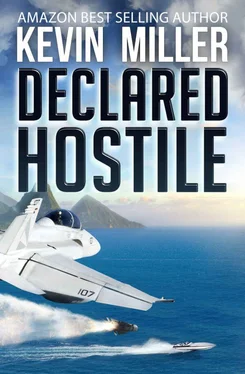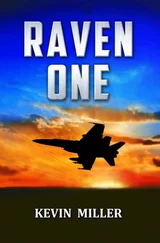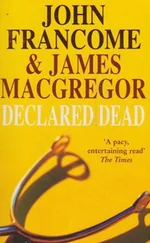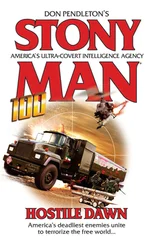“Roger,” Slash 24 replied. Just then, Blocker lead transmitted on strike common.
“ Blockers pushing.”
“ Nightlight copies,” the AWACS controller answered.
They were committing now, and Wilson didn’t know if he had Tomahawks inbound to soften up San Ramón, didn’t know if he had signals intel in the form of an EP-3, didn’t know if the Venezuelans were alerted. He did know there was weather ahead, but he didn’t know if it would pass or get dangerous. And he could guess that the White House press corps were monitoring their watches as they prepared to cover the President’s address to the nation in less than an hour.
Wilson led his formation in an easy left-hand turn. As he watched his preplanned run-in speed align with his planned time on target, he felt a sense of progress. He had ninety degrees to go before he pushed the Slash formations on course behind the Blockers . Above and below were lone twinkling anti-collision lights that marked the Slashes, Volts, and Lances as they, too, waited to push out along the planned track. The others in formation were unseen in the darkness. Wilson could make out some position lights a mile or two away. Soon he could don his goggles.
“ Slash one-one, pushing,” Wilson transmitted.
“ Slash two-one, pushing.”
“Three-one, pushing.”
The twelve Slash strikers rolled out on a heading of 250 and accelerated toward South America, with Wilson in front and the other two division formations on his left and right. Wilson tried his goggles, but the faint, yellow-gray glow was still too much for the light intensifiers. He could discern a line of storms ahead and commanded his radar to air-to-ground mode to get a look at it.
His radar display depicted a ragged — but solid — line of return, almost perpendicular to their track seventy miles away. With his naked eye, he could see lightning ahead of him, small pops of light. Some were sharp but most seemed muffled as they zipped from inside one cloud to another. At this speed, the strikers would be on the storms in eight minutes, and the Blockers before that. He saw that the line extended along the horizon in front of him from Tobago to Guyana. That made it hundreds of miles in length. They couldn’t go around it, and going under it was a nonstarter. We’ll go over it.
Wilson elevated his antenna and saw the return was not much different. Even the horizon line on his HUD was cutting the tops of the cumulus clouds. He was climbing the formation ever so slightly, but in the high twenties, knew that their heavy bomb loads would prevent a much higher climb. It would be impossible, at these weights, to get up to the forties. He had to keep climbing, looking, thinking, and hoping .
Flying into a thunderstorm required him to break a cardinal rule of aviation, and, with eleven bomb-laden wingmen hanging on to him in formation, the stakes were ratcheted way up. He wondered what the Blockers were doing ahead and called lead.
“ Blocker lead from Slash. How does it look?”
“Pretty solid line, but we found a saddleback we can go over.”
“Above forty?”
“Affirm.”
Now Wilson knew at least the Blockers could get over the line at 40,000 feet, but there was no way he could get up there, even in burner, as heavy as they were with bombs and full fuel tanks. With the faintest twilight glow behind the line he could detect anvil-topped clouds south of their track with the anvils also pointing south, which showed the high-level winds from the north were shearing them away. Even in the clear, airplanes near thunderstorms could be pelted, with no warning, by hail thrown up from inside the churning clouds. The fact the anvils pointed away from them gave a degree, albeit small, of comfort.
Level at 30,000 feet, and close to 500 knots ground speed, they floated closer to the line as the flashes increased in intensity. Wilson scanned the line up and down to determine the strongest segments, the tallest clouds, and the thickest concentrations of energy. Far to the north and south — almost 100 miles in either direction — the line’s strength did not seem to diminish. Wilson had to lead the formation through it or turn around.
DCAG — his immediate senior — was right next to him and, so far, had not offered any guidance. Wilson knew Devil Davies was watching his airplanes approach the solid line of weather, as were the controllers aboard the AWACS who transmitted the picture to staff officers in Miami and Washington. It appeared no one was going to jump in and make Commander Wilson’s decision. The line now loomed just off his nose. Inside the base clouds, in the teens and low twenties, muffled bulbs of grayish yellow light pulsed on and off. From this bubbling caldron of energy rose a wall of dappled gray, a shadowy and foreboding tapestry of dark cloud. And jagged veins of electricity shot from cloud to cloud in front of him. A thin stratus layer above obscured what little starlight was available to measure the tops of the serrated “mountain range” now less than forty miles ahead.
Wilson was glued to the radar display, hoping, praying for a break, praying for a call from above, wishing that someone would jump into his cockpit and direct him what to do.
“ Slash, Blockers have punched through, in the clear. May have some weather in vicinity of Bullseye .”
Wilson rogered the call as he struggled with his decision. Fly two dozen jets with live weapons through the weather? Or abort? The Blockers could abort. Nightlight , the Volts and Lances could abort. He knew the aircrews in the aircraft, knew their faces, their young inexperienced faces. All could abort now, and, with weather reported in the vicinity of the target, it was a reasonable call, the right call. It met the go/no-go criteria they had briefed. Wait, did we brief it? Did this scenario fall through the cracks in their haste to launch? What would Washington do if they turned around? How would Devil and CAG react? The big question remained. Should they risk the jets to hit San Ramón on time line, or live to fight another day?? The CNO wasn’t an aviator. Who advising the President was? Did Washington even know or care about the fine details of fuel, time, and distance, or the perils of thunderstorm penetration? Wilson concentrated on his radar as his wingmen concentrated on him to lead them, to take care of them. He continued ahead, delaying the decision to the last minute — the final minute. He continued ahead, praying for deliverance.
A magnificent burst of energy lit up the wall of cloud in front of him, a metallic flash with bright streaks of horizontal lightning stretching for miles. It outlined the details of the cumulonimbus clouds forming the barrier he had to either penetrate now or avoid by turning around. The warning was clear: Don’t come in here . With twenty minutes to the target they had no time to hold and wait, no fuel to spend making decisions, and Wilson knew what lay before him wasn’t going to dissipate in the next minute. The Blockers were already past it. Good . They reported more weather en route to the target. Bad. What to do?
“Looks like a seam to the right,” DCAG transmitted.
Wilson saw it, too, a somewhat clear area between two angry thunder cells of heavy radar returns. The clouds went up 10,000 feet above them… no way to get over them.
Wilson was the strike lead, and it was his call. Grateful for Not-o’s veiled encouragement and implied approval, he swallowed hard, then keyed the mike.
Читать дальше












